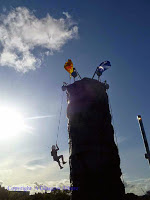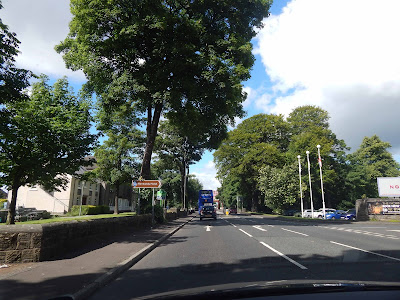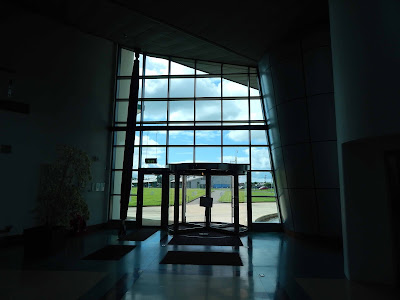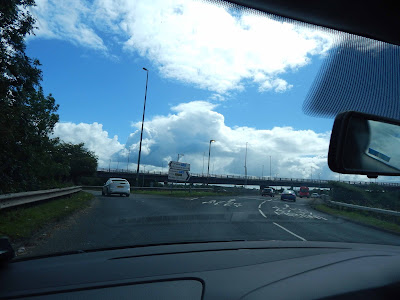 |
Approaching the King George V Dock entrance. For the Dock see
From Wiki - 'King George V Dock is a dock for ocean-going vessels operated by the Clyde Port Authority in the Govan area of Glasgow in the west central Lowlands of Scotland. It is located near Braehead in Renfrewshire and lies on the boundary between the council areas of Renfrewshire and the City of Glasgow.
'A large single basin with unrestricted entry, it opened in 1931 to accommodate the larger vessels then beginning to service the Clyde and was named after George V, the reigning monarch. It is the largest dock on the Upper Clyde, as well as the only operational one within Glasgow's city boundary. The dock currently deals with dry bulk cargoes, including animal feeds, grains, chemicals and industrial equipment, and offers easy transfer of goods to the M8 motorway and the national rail network via the remaining stub of the Glasgow and Renfrew District Railway and the Inverclyde Line. '
|

 |
| We fail to gain access to the Dock |
 |
| Never mind |
 |
| We head back |
 |
| And turn left towards the river |
 |
| The Sentinel |
 |
| We will find the Clyde behind that big metal thingy |
 |
| Scrap metal |
 |
| Giant praying mantis |
 |
| Chains |
 |
| The Clyde |
 |
| Beside the Titan Crane is the Barclay Curle Building in South St, which we have come to photograph, where Scottish Opera stores its sets and stuff. For the history of the building see https://en.wikipedia.org/wiki/Barclay_Curle |
 |
| Looking back |
 |
| Heading back we spot some elephants |
 |
| We are driving to Hillington now |
 |
| Roundabout |
 |
| Another roundabout |
 |
| Get in Lane |
 |
| Going to pull over get some info from the sign |
 |
| The building we seek is not in Hillington. We need to head for Renfrew |
 |
| Off we go |
 |
| Hillington is a bit strange, not quite west of Scotland vibe. Entrepreneurial. Thank goodness. |
 |
| Big Pink Thing |
 |
| Get in Lane |
 |
| Heading for Renfrew Town Centre |
 |
| Nice Scots Baronial touch over there |
 |
| Following that bus |
 |
| We are following the bus across there, into Inchinnan |
 |
| McGills buses rest here |
 |
| Inchinnan Playing Fields |
 |
| We have stopped to ask for direcions. The building we seek, India of Inchinnan, is not where we think it is. |
 |
| The bus driver has told us we need to go back |
 |
| We have pulled off by the church to ask for directions |
 |
| Lovely wee car there |
 |
| The registration number is H766 TEP. Looks immaculate |
 |
| The lady who has told us about the car tells us how to get to India of Ichinnan |
 |
| Back to main road |
 |
| Across and up the right |
 |
| Inchinnan Business Park on left |
 |
| Here is our building |
 |
| From the Inchinnan wiki entry - 'Inchinnan hosts an art deco style category A listed building called India of Inchinnan.
It is the former office block of India Tyres factory which occupied the
site from 1927 until the early 1980s. It has now been renovated into
private offices. The company also built two groups of houses to
accommodate its workers. These streets were called Allands Avenue and
India Drive. Prior to its use as a tyre factory, the site was used by William Beardmore and Company to build airships in World War I. Several airships, the No's R24, R27, R34 and the R36 were built on this site. The company built 52 houses in Inchinnan, at Beardmore Cottages, to house its workers. ' |
|
|
 |
| Some of the other businesses associated with Inchinnan (from the wiki link above) -
'Inchinnan has a large industrial estate within the town. There is a
few manufacturing companies left within the area. Some of the companies
associated with Inchinnan past and present include: 'Reekie Machine
Tools', 'Scot Tubes Ltd', 'Gas Measurement Instruments', 'Bairdswear',
'Armour Park', 'Metecno', 'Aulds' and 'Rolls Royce'. M&Co. (Mackays) has its head office at Caledonia House in the industrial estate.' |
 |
| Ian takes a pic |
































 |
From the listings link above:
Listing Text
'Wallis, Gilbert: 1929-30, Art Deco,
with 5 additional bays at each end added c.1955 in same style. Original
range 15 bays with raised and recessed end pylons, 2 storeys.
Reinforced concrete with red, green, gold and block glazed tile
decoration. Bays divided by giant chamfered piers with glazed tile
decoration to bases and capitals, black glazed plinth; red and black
cill band to ground floor windows; thin green band cvourse between
storeys, wider over 1st floor and to vertical framing of narrow bays.
Central door set in coloured, banded architrave. Black, green and red
terrazzo floor at entrance vestibule with "India, Inchinnan Scotland"
inlaid. All winodws metal framed, recessed except in outer 1/2 bays of
original block. Stepped parapet raised at centre over "India of
Inchinnan". End pylons with doors at ground and bold stylised corbelled
angles. Original 1950s lettering "India Tyres" retained on E gable
end.
Low curved walls enclosing white marble paved forecourt,
with geometric cast-iron rail and original lamp standards; low
pylon-shaped piers and cast-iron rails to front (main road) retaining
wall.'
|








 |
| Off we go |
 |
| Onto the M8 |
 |
| And into the Clyde tunnel |
Thank you for browsing, dear visitor.
My other barking wee blog is
Reviews of Scotland: 1000 Things You Need to Know
RADIO AND TELEVISION
'I love it - I'm giving this copy to a friend and buying another for myself' - Darren Adam, Presenter, Radio Forth, 17 November 2008
‘It’s a great wee book’ – Stephen Jardine, introducing Edwin Moore on Scottish Television’s Five-Thirty Show
'A fantastic book' - Scott Wilson , talk 107 Breakfast Show host
'A great read' - Dougie Jackson, Drivetime host, Smooth Radio 105.2
THE PRESS
'Despite its apparently humorous format, this is a serious and extensive dictionary on all things Scottish; from Jean Redpath to Lorne sausage, from Flodden to the Corries. Is particularly good on history and minutiae. There's a useful chapter on famous Scottish legal cases and another on literature. Excellent' - Royal Scottish Legion, Feb 2009
'This is the ultimate Scottish reference book' - Waterstones Christmas catalogue, 2008
'This is a fascinating look at the history of Scotland: its languages, politics and great achievements, from its origins in the ancient landmass of Laurentia 400 million years ago, to devolution and Billy Connolly. Edwin Moore has collected a thousand important facts about this beautiful country, covering Scottish history and culture, correcting misconceptions, and examining the mysteries of haggis and bagpipes with insight, warmth and impressive attention to detail' - The Good Book Guide, November 2008
'This is a recipe for revealing how horribly ill informed you are about your country. Although, if you are skillful, you can nod sagely as you read some new fact and mutter 'Ah, yes!' as if recalling the information from your excellent schooling. Where else will you find a real recipe for making haggis from scratch side by side with a potted biography of David Hume; a section of the Declaration of Arbroath and the curiously touching fact that Lulu was only 15 when she had a hit with 'Shout'? The whole thing is of course, silly - but oh so addictive.' - Matthew Perren, i-on Glasgow, December 2008
'. . . well crafted and witty' - Bill Howatson, Aberdeen Press and Journal, 18 October 2008
‘While most of Edwin’s entries are entertaining and scholarly – he writes like a Scottish Bill Bryson – it is when he takes an interest in the backwaters of history, the details lost down the back of the sofa, that he is at his best’ – Jack McKeown, The Courier, 27 October 2008
'History, it is said, is written by the victors. Trivia, meanwhile, is written by the guys with the smeared spectacles and the breathable rainwear. The first discipline is linear and causal; to quote from Alan Bennett’s play The History Boys, history is “just one f****** thing after another”. Things look different, though, when viewed through the prism of trivia. The past is reduced to one big coleslaw of fascinating facts that in their randomness tell a more mixed-up tale entirely.
The first approach leads to big, frowning books by the likes of Tom Devine and Michael Fry. The latter results in small, cheerful books such as Scotland: 1,000 Things You Need to Know, Edwin Moore’s valiant attempt to navigate the more trivial contours of enlightenment and clearances, crown and parliament, dirt and deity.
Moore proceeds from a sincere and controversial first principle: Scotland is really a rather pleasant and interesting place. . .As a work of popular scholarship, though, it’s in a different league to the Scottish novelty titles that get stocked next to the bookstore tills as potential impulse purchases, those little handbooks of parliamo Caledonia and regional braggadocio, such as Weegies vs Edinbuggers.' - Allan Brown The Sunday Times, 21 September 2008
'In his book, Scotland: 1000 Things You Need to Know, Edwin celebrates all that sets us Scots as a race apart - our language, law, flora, food, and of course, our people. From our poets, architects and inventors, to our artists, entertainers and fighters. But he doesn't shy away from the more unpleasant aspects of our history. . .' - Robert Wight, Sunday Post, 14 September 2008
‘We think we know all about William Wallace, Robert the Bruce and the Union of the Crowms. However, according to Edwin Moore, author of , Scotland: 1000 Things You Need to Know, we’re still in the dark about many aspects of our history and culture. . . The Big Issue looks at 20 of the most astonishing examples of secret Scotland.’ – The Big Issue, 18-24 September 2008
'What's the connection between Homer Simpson and Larbert, and why are generations of lawyers grateful to a Paisley snail? Need to know more? Author Edwin Moore has gathered 1000 facts like these about Scotland in a quirky new book. Brian Swanson selects a few favourites. . .' - Scottish Daily Express, 13 September 2008
'The palm for Christmas-stocking books seems to have passed recently to popular science, with best selling titles every year such as Why Don’t Penguins’ Feet Freeze? This year there has been a gallant attempt at a historical fight back. Scotland: 1,000 Things You Need to Know(Atlantic Books, £12.99) asks (and answers) such post-turkey questions as ‘How many kings of Scotland died in their beds?’, ‘Who on earth decided that the Declaration of Arbroath was the cornerstone of modern democracy?’ or ‘Why is iron brew spelled Irn-Bru?’ Mark Mazower,History Today; The Best of History in 2008, December 2008
'A real treat for the serendipitous Scotophile' - Reginald Hill
FROM THE INTERWEB
www.Booksfromscotland.com (on the new paperback edition)
Book of the Month, May 2010
'Whether it's Scottish lochs or Enlightenment philosophers, the facts of the devolution referendums or the mysteries of Irn-Bru, myths will be debunked and truths revealed in this light-hearted but rigorous overview of Scottish history and culture.'
Also available for download on Amazon's e-book store is my 100 Brief Encounters
http://www.amazon.co.uk/100-Brief-Encounters-ebook/dp/B006CQ8G84/ref=sr_1_1?s=books&ie=UTF8&qid=1322393003&sr=1-1
Here are some reviews of the print edition (published by Chambers in 2007) -
Edwin Moore's quirky collection of a hundred encounters between (mostly) important historical figures is a gem of a book. Where else could you get concise enlightening accounts of Henry VIII wrestling with Francis I, Geronimo surrendering to General Miles, Ernest Hemingway presenting Fidle Castro with a fishing trophy or (as seen on the books cover) a baby faced Bill Clinton shaking hands with John F Kennedy. A marvelous 'little window on human history. ' - Dominic Kennerk, Waterstone's Product Planning and Promotions Co-ordinator (From the Waterstone's 'We Recommend' list for 2008)
Witty, light and packed with information -- The Sunday Herald
In 1936, in the wake of winning a clutch of gold medals at the Berlin Olympics, the great athlete Jesse Owens was snubbed by an imperious leader, on racial grounds. Popular belief would have it that the leader was Hitler, who is said to have stormed off, furious to see a black man beating European athletes. In fact the man in question was President Roosevelt, who worried that paying attention to Owens' triumphs might be a vote loser. Although Owens and the German Chancellor never talked, Owens claimed that Hitler greeted him with an enthusiastic wave. Such near-misses, shakings of hands and ships-in-the-night meetings are the subject of Brief Encounters – Meetings between mostly remarkable people, a likeable new book by Edwin Moore (Chambers £7.99). Flicking through the index, you will find some expected encounters (Dante stares at Beatrice, Corday stabs Marat, The Beatles strum along to a Charlie Rich record round at Elvis's house), and the book's intriguing and memorable cover shows a baby-faced Bill Clinton manfully gripping the hand of JFK. But Moore has navigated past some of the more obvious collisions, collusions and confrontations of history (there is no Dr Livingstone, I presume) and much of the book's pleasure derives from lesser known incidents.
Inevitably, some of the accounts of earlier meetings are somewhat sketchy but Moore offers some piquant speculation, laced with humour (the book is tagged Reference / Humour, rather than History and this feels right, but the book, though wry and opinionated, never stoops to wackiness). I was intrigued to discover that, though Attila the Hun did die on his wedding night, it was not in drunken and lecherous debauchery, as his enemies maintained, but supposedly because he was generally a simple and clean-living man who had a few too many which brought on a particularly bad nosebleed.
Moore's book is full of such tales – it would be wrong of me to steal the tastiest morsels of his research and pepper this article with them, but look out for a subsidiary reason for the Gunpowder Plot (too many dour and powerful Scots in Parliament); a great meeting of great beards, as Castro wins the Hemingway prize for sea-fishing; Dali bringing a skeptical Freud round to the art of the surrealists; Buffalo Bill's wife claiming an aged Queen Victoria had propositioned him; Oscar Wilde getting a kiss from Walt Whitman, while Walter Scott was more taken with Burns's charismatic eyes. This is an enjoyable and vigorous rattle through some fascinating and believable yarns. My only quibble is that it's a little on the short side – let's have Volume 2 please Chambers! - Roddy Lumsden, www.Books from
Scotland.co.uk



















































































































































































































































































































































No comments:
Post a Comment